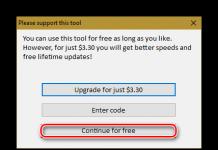Root rights(or superuser) is a special account in UNIX-like systems with identifier 0, the owner of which has the right to perform all operations without exception. In general, root rights give full access to system and hardware data, with the ability to edit or delete them.
Basic Methods receiving root rights access on smartphones Android OS
There is 17
basic methods for obtaining root rights. 1) SuperOne Click
- A program for obtaining root rights using a computer.
All except (as of July 1, 2011):
- Droid Eris (HTC DesireC)
- Droid Incredible (HTC Incredible)
- HTC Aria
- HTC from the Desire series
- HTC Legend
- HTC Wildfire (HTC Buzz)
- Sprint EVO 4G (HTC Supersonic)
-T-Mobile G2
- T-Mobile MyTouch 3G 32A (v1.2)
- T-Mobile My Touch 4G
For the above devices, additional manipulations with the firmware kernel and bootloader are required.
Requirements:
- If you are using a WinXP computer, install Microsoft NET. Framework 2.0 (or higher)
- If using Mac or Linux install mono: http://www.go-mono.com/mono-downloads/download.html
- Drivers are required to connect the computer to the phone via ADB (android debug bridge). They are usually supplied by manufacturers or come in one of the Android SDK Tools.
- Do not connect your phone in sd card mount mode
- Enable at least once the item Settings / Applications / Development / USB Debugging
- In some cases, connecting the phone in recovery mode will help
Getting root
Make sure Settings/Applications/Development/USB debugging is off
Click root
When the application writes " Waiting for Device", enable USB Debugging
After that, the exploit will be launched. RATC
When the message " Starting ADB Server..."
Turn off Debugging USB
Turn on
Turn off again
This must be done before the new message "Waiting for device..." appears.
Works:
- Acer Liquid S100
- Cricket Huawei Ascend
- Garmin Asus A10
- Gigabyte GSmart 1305
- HTC Hero (2.1)
- Huawei U8110
- Huawei U8150 (Android 2.2)
- Huawei U8220
- Huawei U8230
- Huawei U8500
- LG GT540 (2.1)
- LG P500 Optimus One (2.2)
- Motorola Backflip
- Motorola Defy
- Motorola Droid X
- Motorola Droid 1 (2.2.1)
- Motorola Droid 2
- Motorola Quench XT5
- Pocketbook IQ 701
-Samsung Acclaim
- Samsung GT-I5700 Spica
- Samsung GT-I5800 Galaxy 3
- Samsung GT-I7500 Galaxy
- Samsung GT-I9000 Galaxy S (strictly up to Android 2.2.1)
- Samsung GT-P1000 Galaxy Tab
- Sony Ericsson X10
- Sony Ericsson X10 mini
- Sony Ericsson X10 mini pro
- SuperPad (WowPad / Fly Touch II) Infotm x220.
Does not work:
- Archos 70 (unknown)
- Google Nexus One (worked before FRG83D)
- HTC Desire (requires nand unlock)
- HTC Desire HD (requires nand unlock)
- HTC Droid Incredible
- HTC Evo (requires nand unlock)
- HTC Legend
- HTC Magic (unknown)
- HTC Wildfire
- T-Mobile G2 (requires nand unlock)
- T-Mobile MyTouch 3G (unknown)
- Motorola Droid1 (old firmware)
- Samsung GT-I9000 Galaxy S (Android 2.2.1)
- Sony Ericsson X8 (Android 2.1)
Launch and click Shell Root(permanent root) or Temporary Root(temporary root - will fly off after reboot)
After the procedure with shell root you need to restart your smartphone
- Acer Liquid (2.1)
- Acer beTouch E110
- Dell Streak (2.1)
- Gigabyte Gsmart 1305
- Google Nexus One (2.2 FRF91)
- HTC Dream (1.6)
- HTC Hero OS version: 2.1-update1, Software number: 3.32.411.1 (firmware via RUU)
- HTC Hero OS version: 2.1-update1, Software number: 3.32.411.2 (OTA update)
- HTC Magic (1.5)
- HTC Tattoo (1.6)
- HTC Legend (rooted before reboot)
- Motorola ME511
- Motorola Milestone (2.1)
- Motorola Droid (2.2)
- Motorola Quench XT5
- Motorola XT701
- Motorola XT800 (2.1)
- Orange San Francisco
- Sony Ericsson X10 (1.6)
- Sony Ericsson X10 Mini
- Sony Ericsson X10 Mini Pro (1.6)
- LG GT540 (1.6)
- Vibo A688 (1.6)
Install the program in the phone's memory.
We launch.
We select our axis in the spoiler.
We press root.
We are waiting for the end and reboot.
Google
- Nexus One
- Nexus S Android 2.3.4
high screen
- Zeus 1.5
HTC
- Desire HD 2.2 (1.72)
- Desire Z 2.2 (1.72)
- Wildfire
- Incredible S
LG
- Optimus One P500 2.2.1
Sony Ericsson
- Xperia X10
For the application to work, you MUST enable the USB debugging mode (Settings - Applications - Development - USB debugging)!
Install in the phone's memory. Open the program and select the desired item:
Temproot on boot - automatically allow temproot on device boot (author recommends running temproot manually before enabling this option to check if everything is ok)
Run visionary.sh after root- allows the script to be run (as root) after gaining root privileges. The script file is located under /data/local/visionary.sh
Set system r/w after root- allows you to remount the system partition for reading / writing after gaining root privileges
Temproot now- activate temproot (root rights will be lost after reboot)
Attempt permroot now- an attempt to obtain permanent root privileges (it is strongly recommended to read the IMPORTANT section before applying!)
Unroot now- completely disable root privileges
After reboot the device
- Acer Liquid (2.2)
- Acer Liquid MT Android 2.2 (1.100.35)
- apad imx515 (2.3.3)
- Dell Streak (2.2.2)
- Desire HD (2.3.3) - ONLY WITH S-OFF!
- HTC Desire S, Incredible S - ONLY WITH S-OFF!
- Google Nexus One (2.3.3)
-Highscreen Cosmo
- Huawei S7 (2.2)
- LG Optimus 2x (stock)
- LG Optimus Black (2.2.2) - wrote in a personal
- LG Optimus One (2.2.1)
- LG P 350 (2.2.2)
- Motorola Defy (firmware: 3.4.2-155)
- Nexus S (2.3.3)
- Samsung GT-I9003 Galaxy S scLCD (2.2.1)
- SE Arc
- SE Xperia Play
- SGS (2.3.3)
- ViewSonic 10s (2.2)
- Viewsonic Viewpad7 (2.2)
1. Install the program in the phone's memory.
2. Turn on USB debugging. To do this, go to Settings -> Applications -> Development -> USB Debugging. We put a tick.
3. Check that the flash drive is inserted and working
4. Run GingerBreak
5. Choose Root Device
6. Wait a few minutes. If there are no problems, the device will reboot (I note that the reboot may take a long time, so we are waiting)
7. Rejoice!
1. Download the MTKdroidTools program
2. On the phone, you need to activate USB debugging, for this we go to the settings> developer options> USB debugging> tick
3. We start the installation of the MTKdroidTools.exe program and connect the device to the computer,
4. We wait until the program issues a request “Install su, superuser, rootexplorer?” Click confirm and wait for the process to finish.
5. Disconnect the device from the computer, and do a reboot
1. Install the driver for your Android device
2. Install Unlock Root and enter the key from the text document in the archive
3. Enable USB in debugging mode (Settings->For Developers->USB Debugging)
4. Connect your device to your computer
5. Wait until the program detects the device. Next click Root
6. That's it, the rooting process has begun (During the rooting process, the phone will reboot several times)
7. Wait for it to complete, after which you will be prompted to install Battary Saver (If not, refuse)
8. After all this procedure, reboot the device again
9. You will be able to check if you have got Root rights on any application that requires Root
1. Install Framaroot
2. Run, select Superuser or SuperSU, to choose from, but SuperSU is better.
3. Click Gimli, Sam, Frodo, Legolas, Aragorn, Gandalf, Boromir i.e. any character you like, if available :D
4. A window with a smiley popped up :-) about successfully obtained Root-rights (see screen).
5. We reboot the device and rejoice: D!
6. After getting root rights, Framaroot can be deleted!
Compatible with the following Qualcomm devices (Gandalf exploit):
Compatible with the following MediaTek devices (Boromir exploit)
Compatible with the following Huawei K3V2 devices (Pippin exploit)
Compatible with the following AMLogic devices (Gollum exploit)
Compatible with the following Samsung devices (Legolas, Aragorn exploits)
Compatible with the following Exynos devices (Sam, Frodo, Legolas, Aragorn exploits)
Compatible with the following Omap devices (Gimli exploit)
Google Nexus 4
Google Galaxy Nexus
Google Galaxy Nexus S
Google Galaxy Nexus One
Nexus 7 2013 WiFi
HTC 920E
HTC Wildfire S
HTC Wildfire
HTC Vision
HTC Thunderbolt
HTC Tattoo
HTC Sensation
HTC Salsa
HTC Runnymede
HTC Rhyme
HTC Rezound
HTC Raider 4G
HTC Primotd
HTC Primotds
HTC One X
HTC One V
HTC One S (S3)
HTC One S
HTC One
HTC Mytouch 4G Slide
HTC Mytouch 4G
HTC Mytouch 3G
HTC Magic
HTC Legend
HTC Incredible S (G11)
HTC Incredible 2
HTC Incredible
HTC Hero 200
HTC Hero
HTC EVO Shift 4G
HTC EVO 4G
HTC EVO 3D GSM
HTC EVO 3D CDMA
HTC Droid Eris
HTC Dream
HTC Desire Z
HTC Desire S
HTC Desire HD
HTC Desire
HTC Chacha
HTC Aria
HTC Amaze 4G
Samsung Galaxy Note (i9220)
Samsung Galaxy Note II (N7100)
Samsung i500
Samsung i535 Galaxy S III
Samsung i699
Samsung i777 Galaxy SII
Samsung i879
Samsung i939
Samsung i959
Samsung i9000 Galaxy S
Samsung i9001 Galaxy S Plus
Samsung i9100 Galaxy SII
Samsung i9105 Galaxy S II Plus
Samsung i9152 Galaxy Mega (5.8)
Samsung i9300 Galaxy S III
Samsung i9308
Samsung S5830 Galaxy Ace
Samsung S5660 Galaxy Gio
Samsung i9500 Galaxy S IV
Samsung S7562 Galaxy S Duos
Samsung T959 Vibrant
Samsung Galaxy Tab 2 (7.0)
Samsung Galaxy Note 10.1 GT-N8000
Samsung GALAXY Tab 3 WiFi+3G
Samsung Galaxy Mega 6.3 i9200
Samsung Galaxy Gran Duos GT-I9082L
Galaxy Tab 2 10.1 (P5100)
Samsung S7562 Galaxy S Duos
Samsung Galaxy S III mini GT-I8190
Samsung Galaxy Ace 2 (i8160)
Samsung Galaxy Grand Duos (i9082)
Samsung Galaxy S III L710(SPRINT)
Samsung Galaxy Xcover2 (GT-S7710)
Samsung GT-S5690 Galaxy Xcover
Samsung Galaxy S4 (GT-i9500)
Samsung Galaxy Tab 8.9 P7300
Samsung Galaxy Mega 6.3 I9200
Samsung SM-T3100 Galaxy TAB 3 8.0
Samsung GT-I8552 Galaxy Win DUOS
LG Optimus Black (P970)
LG Optimus 2X (P990)
LG Optimus One (P500)
LG Optimus 3D (P920)
LG Optimus G2X (P999)
LG Optimus Pro (C660)
LG Optimus Hub (E510)
LG Optimus Sol (E730)
LG Optimus LTE (LU6200)
LG Optimus L3 (E400)
LG Optimus Net (P690)
LG Optimus L5 Dual E615
LG Optimus 3D MAX P725
LG Optimus L7 P705
LG Optimus L4 E440
Motorola DEFY Me 525
Motorola DEFY Me 525+
Sony Xperia TX (LT29i)
Sony Xperia S (LT26i)
Sony Xperia Z (L36h)
Sony Xperia Arc S (LT18i)
Sony Xperia Arc (LT15i)
Sony Xperia Neo (MT15i)
Sony Xperia ZL
Sony Xperia Z Ultra
Sony Xperia Acro S
Sony Xperia P
Sony Xperia E C1505
Sony Xperia ion (LT28h)
Sony Xperia sola
Sony Xperia Neo L MT25i
Sony Xperia L (C2105)
Sony Xperia U (ST25i)
Sony Xperia ZR (C5502)
Prestigio MultiPhone 3540 DUO
Prestigio MultiPhone PAP 4322 DUO
Prestigio MultiPhone 4505 DUO
Prestigio MultiPhone 4040 DUO
Prestigio GeoVision 7777
Prestigio MultiPad 2 PMP7380D PRO DUO 8.0 3G
Prestigio MultiPad 7.0 Prime Duo
Explay Vision
Sharp SH530U
ZTE 880
ZTE V970M
ZTE MT7A Megafon Login
Alcatel One Touch 5020D M"POP
Alcatel One Touch SPop 4030D
Alcatel One Touch 6010X Star
Globex GU904C
DEX ip821
DNS AirTab M104g
DNS S5301M
DNS AirTab P100qw
ASUS Eee Pad Transformer TF101G
Huawei Link10
Huawei S8600
Huawei Ascend G510-0200
Huawei U8800 Pro Ideos X5 Pro
Huawei MediaPad 7 Vogue
Huawei MediaPad 7 Vogue (Lite 2)
Huawei Ascend G610-U20
Zopo ZP100
Lenovo P770
Lenovo IdeaTab S6000
Lenovo IdeaPhone P780
Wexler.Book T7008
TG Teamgee Super8 E1
Digma iDxD4 3g
Qumo QUEST 570
Fake Goophone i5 (iPhone 5. MTK6575. 854x480)
Mini Pc Tv Box Rockchip Rk31
Explay Surfer 10.11
Fly IQ246 Power
MTS 972
iRU Pad Master M704G
MTS 960
xiaomi mi2s
Ritmix RMD-770
0. Be a full administrator on the computer and temporarily disable the firewall / firewall or whitelist Kingo Root in the firewall / firewall. It will not be able to download the driver under the proxy, you need to install the driver for the phone yourself
1.
Install KingoROOT.
2.
Run Kingo ROOT and connect your phone with USB debugging enabled and with "Unknown Sources" checked.
3.
Kingo ROOT will start downloading the drivers and installing them.
4.
After installing the driver, the ROOT button will appear, click on it.
5.
We are waiting for the root to be installed and the phone itself will reboot.
6.
We rejoice at the received root.
P.S. If someone has a program that reinstalls the driver, then we restart the computer and phone.
11) Root with Restore by Bin4ry is another tool to get root permissions. In this case, it is obtained by restoring data in the phone. This method works on a fairly large number of smartphones and tablets, which makes it useful.(C)(C)(C)(C)
1. Download and unzip the archive to a convenient location
2. Run "RunMe.bat"
3. Select the item with the name of the device ( for all except Xperia and LT, select the item 3
)
4. We agree to restore on the device
5. We are waiting for the phone to completely reboot 2 times
6. Disconnect the phone (tablet) from the computer
7. Rejoice Root!
We do not disconnect the phone (tablet) from the computer until the process is completed!
Officially supported devices:
Sony Xperia: S, T, P , Acro S, Ion , Tipo , Tablet S, Go, Sola, U
Google: Nexus 7
XTouch:X401
Jiayu: G2-S
LG: P705
HTC: One S, Sensation XL, Sprint's OTA ICS update on Evo3D, Desire S
Kyocera: Rise & Hydro
Samsung Galaxy S2
Ainol: Novo 7 Tornado 7
Prestigio: MultiPad PMP5197D 9.7 ULTRA
HDC: I9300 S3 Clone
1) Download the archive Android 2.3+ below.
2) Reboot into recovery.
3) We make a backup of all data.
4) Go to install zip from sdcard we are looking for our archive and flashing it.
5) After the end of the firmware, we reboot and have a full-fledged root.
1) install the program and accept the agreement (in non-translated versions, the button is in the lower right corner)
2) refuse to upgrade (requests not always)
3) click on the "get root" button (in non-translated versions, a big blue button in the center)
4) wait. The program will notify you when the root is received. (Lights green)
Attention! All actions you perform at your own risk! No one is responsible for possible negative consequences for your device!!
If all the methods did not work on your Android device, then you
here
P.S.
The article is dishonestly copied from here
Personally, to get the root on the tablet 3Q tablet PC RCp731C-BL helped Baidu root, and on the phone LG P715 helped Framaroot
Updates have long been a problem for users of rooted Android devices. When installing an update, the root often flies, but a fresh version of the operating system for the smartphone is still needed. A new app called FlashFire eliminates them.
Update after root
Why do updates annoy rooted phones?
Android is based on Linux, so Android devices include a “root” user, similar in function to the administrator account in Windows. By default, Android does not provide access to this user's account. Rooting is the process of gaining access to the root account while installing the su binary. Applications call su to gain elevated privileges, which means they can break out of the Android sandbox and do something bigger. Android comes without root to avoid user security breaches, especially for non-tech-savvy users.
SuperSU

In the process of obtaining root rights, the SuperSU application is also installed, which controls access to the su binary, inside which you can allow and deny root access to applications.
Lollipop
When installing an operating system update, root access is usually lost. In Lollipop and earlier versions of Android, the update resets the system partition to factory state, removing the su binary. On newer rooted devices, the boot image is overwritten. If custom recovery is installed, then the standard update may not be installed at all.
SuperSU once had a "survival mode" for flashing updates, but it was removed after the release of the FlashFire application.
FlashFire by Chainfire

FlashFire is a powerful application from Chainfire, the developer of SuperSU, which, if rooted, provides rich functionality: flashing update files, including in zip format, creating and restoring backups, erasing data, and much more. It eliminates the need to manually copy and restore with the help of recovery, and also automatically removes root and re-roots when flashing update files.
Basically, FlashFire should work on most Android 4.2+ devices. However, there are a number of reservations.
On many devices, the presence of root interferes with downloading and updating firmware. On some devices, the update is downloaded, but it requires a tool like FlashFire to flash it successfully. On other devices, the update is not downloaded at all, so you will have to get the update file in a different way (they are posted on forums such as w3bsit3-dns.com and XDA Developers), and then flash it through FlashFire. Nothing will work without the update file.
What's more, if a rooted device needs to get a major OS version upgrade, such as from Lollipop to Marshmallow, the task gets more complicated. Since it is impossible to root Marshmallow without unlocking the bootloader, if the bootloader is blocked, root rights will inevitably disappear. If the bootloader has been unlocked, then the FlashFire application will be able to save (or restore) root access after the update is completed.
So, although FlashFire is not guaranteed to work on every device, it is nonetheless commendable. FlashFire is installed from the Play Store.
Installing android updates

If you receive a notification that an update is available for your device, download it, but do not install it yet. You will not be able to immediately install the update on a rooted device.
After the update has finished downloading, launch FlashFire. It will automatically find the update file and ask if you want to flash it, then click OK. This will open a window that can scare beginners - this is a list of operations that FlashFire intends to perform with the update file. Each operation is configured by clicking on it. Say, in order not to erase the cache section, uncheck this item. You can add other actions, but this is not yet desirable.
Custom recovery
A custom recovery called TWRP will be backed up in FlashFire before the update is launched, and will be restored afterwards.
When finished with the set of commands, click the “Flash” button. FlashFire will tell you that the download will take some time and a couple of black windows will appear. Then click OK again.
After that, FlashFire will reboot, displaying a long scrolling text on the screen. Do not touch the device - it's just FlashFire executing the necessary commands. The app will reboot again when it completes the update firmware and restore root. That's all.
If the update firmware does not work

If any modification of the device prevents FlashFire from applying the update - for example, the presence of a custom kernel or changing the / system partition through the Xposed Framework application - then the update will not get up. There is no notification that the update has been successfully applied yet, so you will have to go to Settings > About phone and check if the build number has changed. If not, then the update was not applied (also, most likely, Android will notify the user to install the update).
If this happens, download the factory image for the device, if available.
Once downloaded, copy the .tgz factory image file to your phone's internal storage or SD card.
Launch the FlashFire application and click on the floating action button (red button with a plus) in the lower right corner, then select "write firmware project".
This will open the file manager, by default displaying the root folder from the internal memory. Scroll down until you find the file copied to your device.
If the image file is selected, the FlashFire application will read the archive to check its contents, then present a list of flashable elements. Choose only what you need - to leave your custom recovery untouched, deselect the recovery option.
After that, click on the checkmark in the upper right corner. The application will again present a list of actions where you can change something if necessary.
After checking all the steps, click the "Flash" button. You will see the same notification from FlashFire about waiting for the download time and a couple of black screens, then click OK.
FlashFire will reboot and get to work. Flashing a complete image file will take a lot of time. After its completion, the application will restart again, and now everything is ready.
This is only a small part of the current capabilities of FlashFire. In the future, they will become even wider.
In the "Security" subsection, activate "Unknown sources". Now you will need one of the special programs to activate root rights through the computer and get full access to the system. Let's describe the most popular applications that support most models of tablets and smartphones. Kingo Root The Kingo Root utility must be installed on the PC before rooting Android. Make sure USB cable debugging has been enabled on your phone. Go to the installed program on your computer, then connect your tablet or smartphone via USB. Next, to obtain root rights, follow a simple sequence:
- The application will detect the device, click in the "Root" utility window.
- Wait until the work is completed, reboot the device.
On some Sony and HTC models, the bootloader is not unlocked; in the process, the King Root program will offer to do this.
how to remove root rights android
These programs have their pros and cons, which will be described in the next paragraph. Many users, in addition to root rights, also install custom Recovery.
Recovery is a boot mode that is standard on all Android models. The standard boot mode is responsible for updating the system.
Important
Custom gives much more rights. First of all, they are suitable for those who like to constantly do something with their device, namely: install any patches and fixes, selectively delete unnecessary files without the risk of deleting unnecessary ones, etc. For those who want to completely remove root rights, it is imperative to uninstall Recovery, because, even after removing the "super rights", a third-party bootloader can easily restore them.
Removal of Recovery occurs only with the help of device firmware, tk. utilities for removing root rights, for the most part, do not remove custom boot mode.
How to remove root rights from android?
This program is used by developers to install official firmware on Android devices. You can download it from the link http://forum.xda-developers.com/showthread.php?t=1728605.
- Download and install Samsung and Samsung USB drivers (Follow the link http://developer.samsung.com/technical-doc/view.do?v=T000000117, download drivers).
After downloading, find the ZIP file to open the archive, double-click on it, then extract the driver installer and run it, initiating their installation. - Turn off the Android device for later launch in a special mode.
- Hold down the "Volume -", "Home" and "Power" keys at the same time - the device should turn on in the "Download" mode.
How to get and how to remove root rights on android
After that, we hold down 3 buttons: "home", "volume -", and "power". We turn on the download mode and connect the gadget to the PC via USB.
We launch Odin3 and see a green square (if we don’t see it, then the driver installation was unsuccessful). In the program, click on the PDA and find the same .tar.md5.
We leave the checkboxes only for "PDA" and "Auto Reboot" and click "run". After the procedure is completed, the Odin3 program will write "Done". How to find out if ROOT rights have been removed We remind you that in order to find out about removing root rights, you need to use the Root Checker application. Which need to be opened after the uninstall process. The program should not detect traces of root rights.
To do this, click "Verify Root Status". If "special" rights are found, the icon will turn green and vice versa.
How to get root rights on android?
Attention
If you need to send your device in for repair, just roll back to the original (backup) firmware and no one will ever know you were rooted. 2. Turning the phone into a “brick”: If rooting fails, there is a risk of turning the device into a so-called “brick”.
The surest way to avoid breaking your phone is to carefully follow the instructions when obtaining root rights on trusted web resources, mobile portals. Make sure the manual applies to your device and that custom firmware is compatible with it.
Pay attention to user reviews with a similar device: perhaps they have already installed the root, or vice versa - they turned it into a “brick” and are in shock. 3. Increasing vulnerability. Granting root rights on Android reduces security.
Services and applications with unlimited rights can create a vulnerability.
How to restore root rights?
Any running application can also use these rights with the consent of the user. Root user = superuser. His rights are not limited, he can access any file or folder, perform any file operation in the Android OS.
In simple words, root access is the ability to work with the root file system in the Android OS without restrictions. What happens when rooting? Rooting - modification of the file system in order to provide superuser rights to the root directory of a smartphone / tablet. The root program gets full access to Android. As a result, the root user has an unlimited list of rights on the Android device. If the program is granted superuser rights, it can also do whatever it wants on the phone. How to know if a phone is rooted It's actually very easy to find out if a phone is rooted.
How to remove root rights on android
Thanks to the openness of the Android OS, its users get ample opportunities to configure and manage the shell of mobile devices. But by default, full access to system settings is blocked.
To activate it, you need root rights on Android. In this article, we will explain what root is, how to enable and disable access quickly and reliably.
- 1 Why do you need
- 2 How to enable via PC
- 2.1Kingo Root
- 3 Enable directly on the device
- 3.1 Framaroot
- 3.2KingRoot
- 4 How to use and how to disable
- 5 Conclusion
What is needed What is Root? Translated from English - this is the root, in the context of the OS - the right to access and change system directories. The user becomes an administrator with advanced system management capabilities.
How to remove root rights from android completely
Do not forget that they can be disabled at any time - for example, to restore the warranty or get the manufacturer's firmware. How to enable via PC Let's discuss how to get root rights on Android.
This can be done using utilities, some of which are installed on a computer, others directly on a mobile device. Before you get root rights from a computer, perform 2 important steps on your tablet or smartphone:
- Connect USB debugging: in the settings menu, open the "Accessibility" section, the "For Developers" sub-item, activate "USB Debugging". If there is no developers section in the menu, find the “About phone” subsection, click on “Build number” several times in a row until a notification appears that you are made by a developer.
- Allow installation of programs from third-party resources.
How to restore root rights on android
Reasons for removing root rights:
- After rooting a smartphone or tablet, the device started
- You have rooted a device that is still under warranty. A smartphone or tablet computer is out of order, and you need to contact a service center for repair (devices with root access are not repaired for free, you must give up superuser rights and hide all traces of getting it).
- The user fears that after getting root rights, his device has become less effectively protected from viruses (malware, of course, multiplies, but this does not mean at all that you will protect your gadget from it by giving up root rights and returning to factory settings.
How to remove root rights from an Android device: three ways to solve the problem? Above, we have listed the reasons why users can refuse root access.
How to get root rights on android
The only exception is the devices of the Samsung Galaxy model line, but even here the solution to the problem has long been found by specialists. Method 1: Remove Root rights manually 1. On our site you can find and download free file managers that allow you to view the root file system of your Android smartphone or tablet.
The most popular ones are ES File Explorer, Root Browser and X-Plore File Manager. If you don't have a file manager installed on your device yet, download it, install it and open it.
2. Open the /system/bin/ folder, find the su file there and delete it. To do this, you need to click on this file and, while holding it down, select "Delete" in the proposed menu.
If there is no such file in the open folder /system/bin/, then it may be somewhere else (the specific location of the file depends on the root file system of the device). 3.
In this article, we will consider questions about why and how to remove root rights. One part of experienced users of the Android operating system wants to get root rights in order to customize their gadget for themselves and do it as efficiently as possible. There is another part, these want to get rid of the administrator mode and remove the root rights.
Why remove root rights
The reasons for this may be different. Here are a few main ones:
- the user worries about the security of installed applications and is afraid of malware, because a device with special rights is less protected;
- a lot of “bugs” appeared in a smartphone or tablet;
- the device began to discharge quickly;
- the user wants to hand over his smartphone to a repair service under warranty (the presence of root rights deprives the warranty);
- if the device is in inept hands, with the presence of root rights, it can easily turn into a lifeless "brick" (an inexperienced user can delete something necessary for the system to work).
 Next, we will analyze in detail how to remove root rights on android. There are several ways to remove. Let's consider each of them. The first way: manually deleting or using a file manager. A file manager is required to access the root system of an Android device. The most famous of them are: X-Plore File Manager and ES File Explorer. In addition to the file manager, you will need the Root Checker application. All this can be downloaded for free in the Play Market.
Next, we will analyze in detail how to remove root rights on android. There are several ways to remove. Let's consider each of them. The first way: manually deleting or using a file manager. A file manager is required to access the root system of an Android device. The most famous of them are: X-Plore File Manager and ES File Explorer. In addition to the file manager, you will need the Root Checker application. All this can be downloaded for free in the Play Market.
After the installation of the file manager is complete, open it and delete the su. Which is located along this path /system/bin/. The su file may not be in this folder, look for it elsewhere, because. its location depends on the specific Android device.
Next, go to the /system/xbin/ folder and find the su. We remove it in the same way as the first one. In some cases, you can find the busybox file in folders, instead of su. You need to do the same with him. Lastly, delete the Superuser.apk or SuperSu.apk file, which is located in the / system / app folder. The name of the file to be deleted depends on how the root rights were obtained. After the done manipulations, reboot the device and run the previously downloaded Root Checker application. If everything was done correctly, the application will not detect the presence of "special" rights.
The root rights of the Android operating system can be managed using a personal computer. Thanks to special software, you can both access the rights and remove them from the device. Each device has its own programs for flashing. For example, for Lenovo devices, this is “Lenovo Downloader Tool”, for Xiaomi “Xiaomi Flashing tool”, for Samsung “Odin3”, etc. For firmware, it is better to use official utilities, because they will give a more confident result and will not lead to problems with the android device.

Removing root rights through a computer, as a rule, occurs by removing the old firmware and installing a new one. This is due to the fact that in most standard firmware access to "super rights" is initially absent. Replacing the firmware is a radical method, so it is recommended to transfer all data from the device, even those on the memory card. Usually, flashing a device through a computer is required when it is not possible to remove root rights using mobile applications or manually.
Finding firmware on the web is quite easy, the main thing is to download it from trusted sources. Usually, tips on firmware and the firmware themselves are posted on special sites dedicated to the Android operating system. There are many such sites. It is enough just to drive in Google “android firmware” and phone model. Also on the Internet there are a lot of instructions for flashing a smartphone, where each stage of the process of flashing an Android device is described in detail.
Consider the firmware process using the example of an LG smartphone. First of all, we download the “flash driver” LG Flash Tool, drivers for connecting a smartphone and a PC (drivers are not necessary, usually the need for them arises when automatic drivers are not installed correctly and the computer does not see the device), and in fact, the firmware itself, which is easily found on the network. Next, you need to put the phone into download mode by turning it off and holding down the "volume +" button, connect it to the computer's USB port.
First of all, we download the “flash driver” LG Flash Tool, drivers for connecting a smartphone and a PC (drivers are not necessary, usually the need for them arises when automatic drivers are not installed correctly and the computer does not see the device), and in fact, the firmware itself, which is easily found on the network. Next, you need to put the phone into download mode by turning it off and holding down the "volume +" button, connect it to the computer's USB port.
Now about the firmware utility itself. Opening the LG Flash Tool, click "Select KDZ file" and select the firmware. The path to the file must not contain Russian characters. Next, there will be 2 items: "normal flash" and "cse flash". The first means firmware with saving user data. And the second erases everything, returning the phone to the factory state. Then click on "Start" - the process has begun. If an error occurs during the download, do not be afraid. You need to get the battery and putting it back, click on reload. This is how a device from LG is flashed. In most modern Android smartphones or tablets, the flashing process is approximately the same, with the exception of specific software features and models. Replacing the firmware removes access to root rights and returns the device to its original software environment. A separate story with the Samsung Galaxy family, which we will consider below.
If even after such a radical method of removing root rights, there are some “glitches”, you need to perform a full factory reset, which is present in every model with the Android OS.
How to remove root rights from phone
Despite the possibility of flashing a smartphone or tablet, most users prefer to manipulate root rights in the device itself. The easiest way has already been described above - this is manual removal. It does not require any software to be installed. For those who do not want, or for some reason cannot remove root rights manually, there are special applications that will help in this difficult task. For novice users, there are several applications where you can remove root rights from your phone or tablet in a couple of clicks.
For most models, two applications are suitable - this is Universal Unroot. Both download from the Play Market. The first is suitable for those who do not have custom (third-party) firmware installed, and the second is paid ($1). These programs have their pros and cons, which will be described in the next paragraph.
Many users, in addition to root rights, also install custom Recovery. Recovery is a boot mode that is standard on all Android models. The standard boot mode is responsible for updating the system. Custom gives much more rights. First of all, they are suitable for those who like to constantly do something with their device, namely: install any patches and fixes, selectively delete unnecessary files without the risk of deleting unnecessary ones, etc. For those who want to completely remove root rights, it is imperative to uninstall Recovery, because, even after removing the "super rights", a third-party bootloader can easily restore them. Removal of Recovery occurs only with the help of device firmware, tk. utilities for removing root rights, for the most part, do not remove custom boot mode.
Applications and programs for removing ROOT rights
Consider applications for removing root rights in more detail. As already mentioned, the application will help if the device does not have third-party firmware. After starting SuperSU, open the "settings" tab and after reading the window that appears in detail, click "continue". After the root removal process, reboot your device. The second Universal Unroot app works in the same way, but is more efficient.
Samsung Galaxy devices stand apart in the case of removing root rights. It's a little more complicated here. To remove "special" rights, you will have to download:
- official firmware and find the .tar.md5 file there;
- the Odin3 program, which is used for firmware;
- Samsung and Samsung USB drivers.
To start removing root rights on Samsung Galaxy, you need to turn off the device to start in a special mode. After that, we hold down 3 buttons: "home", "volume -", and "power". We turn on the download mode and connect the gadget to the PC via USB. We launch Odin3 and see a green square (if we don’t see it, then the driver installation was unsuccessful). In the program, click on the PDA and find the same .tar.md5. We leave the checkboxes only for "PDA" and "Auto Reboot" and click "run". After the procedure is completed, the Odin3 program will write "Done".
 We remind you that in order to find out about removing root rights, you need to use the Root Checker application. Which need to be opened after the uninstall process. The program should not detect traces of root rights. To do this, click "Verify Root Status". If "special" rights are found, the icon will turn green and vice versa.
We remind you that in order to find out about removing root rights, you need to use the Root Checker application. Which need to be opened after the uninstall process. The program should not detect traces of root rights. To do this, click "Verify Root Status". If "special" rights are found, the icon will turn green and vice versa.
Once again, we recall the "hard reset" function, which must be applied in case of problems after removing root rights. By the way, on the Samsung Galaxy, the reset can be done manually (for example, in the case of a constant reboot of the gadget). To do this, with the device turned off, hold down the buttons: “home”, “volume +” and power. After that, using the volume buttons, we are looking for the item "reset settings" and press the power button on it.
 Finally, let's remember another problem for Android users related to root rights - the . With which you can access super rights. The utility has great functionality and its official version does not pose a threat to the system. However, recently the program began to be hacked, turning it into malware that can access personal data, slow down the device and quickly drain the battery.
Finally, let's remember another problem for Android users related to root rights - the . With which you can access super rights. The utility has great functionality and its official version does not pose a threat to the system. However, recently the program began to be hacked, turning it into malware that can access personal data, slow down the device and quickly drain the battery.
How to get ROOT rights on Android
Today, the market is supplied with a mass of mobile devices based on the Android operating system from such well-known ...
Today, getting Root rights on Android opens up a lot of new opportunities for users, so developers ...


































